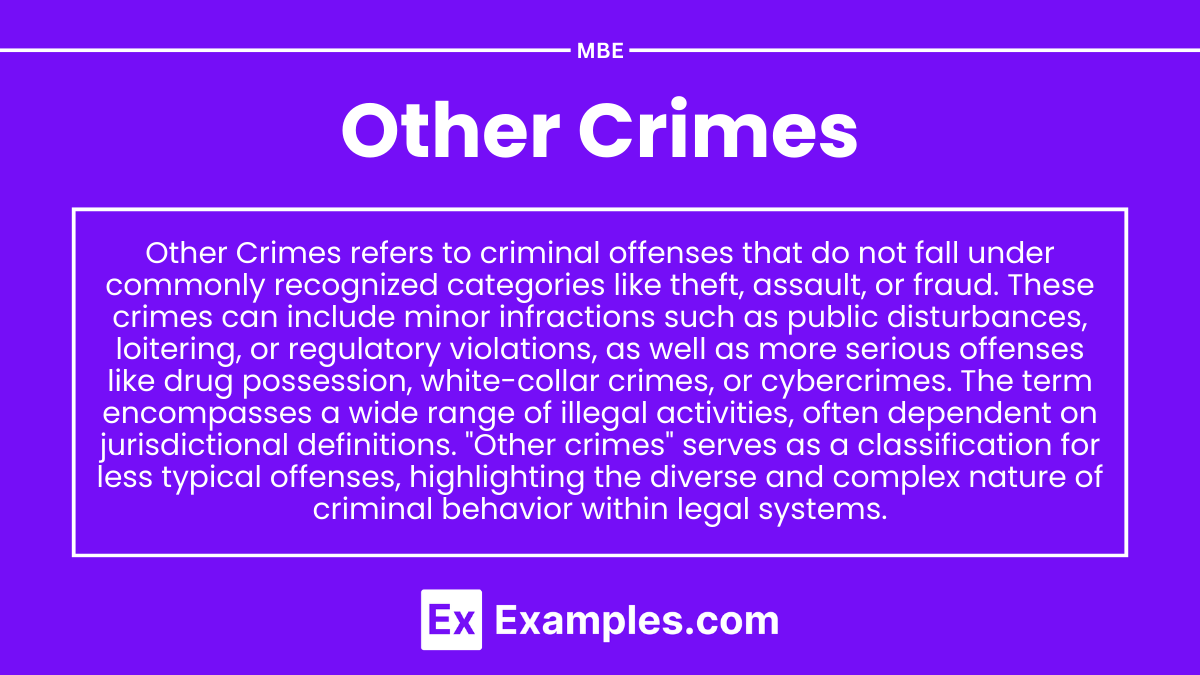Preparing for the MBE Exam requires a comprehensive understanding of Other Crimes, covering the theoretical foundations and practical applications of criminal law. This includes examining offenses such as larceny, burglary, robbery, arson, and false pretenses. Proficiency in distinguishing between these crimes, understanding their essential elements, and analyzing the requisite mental states is crucial for exam success. Additionally, understanding legal doctrines like constructive possession, habitation rules, and the role of intent in property-related offenses is critical.
Learning Objectives
In studying Other Crimes for the MBE Exam, you should learn to understand their critical role in criminal law and their application to fact patterns. Other crimes include offenses such as theft, robbery, burglary, arson, and forgery, each requiring distinct intent and elements. Understanding the distinctions between crimes like larceny and embezzlement or burglary and trespass is essential. These concepts are vital for analyzing scenarios, applying laws, and distinguishing between related offenses while considering defenses such as duress, mistake of fact, and consent. Mastery of these areas ensures accurate issue-spotting, refined reasoning, and strong performance, which are critical for success in the MBE Exam.
1. Larceny
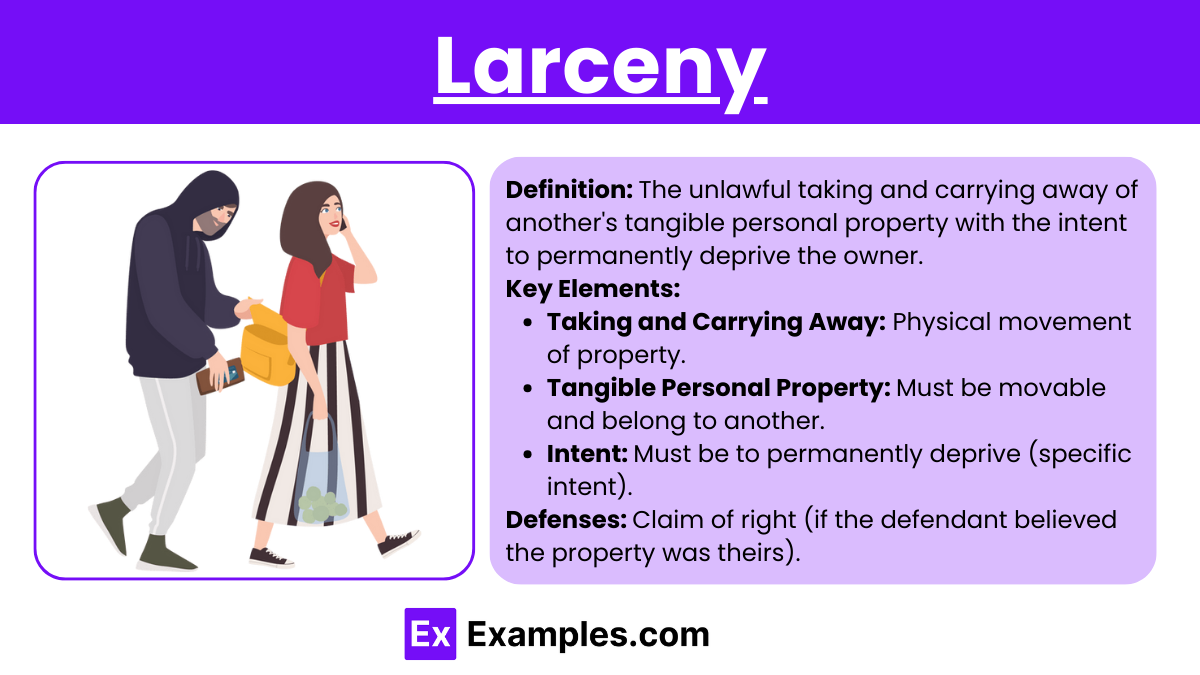
Definition: The unlawful taking and carrying away of another's tangible personal property with the intent to permanently deprive the owner.
Key Elements:
Taking and Carrying Away: Physical movement of property.
Tangible Personal Property: Must be movable and belong to another.
Intent: Must be to permanently deprive (specific intent).
Defenses: Claim of right (if the defendant believed the property was theirs).
2. Burglary
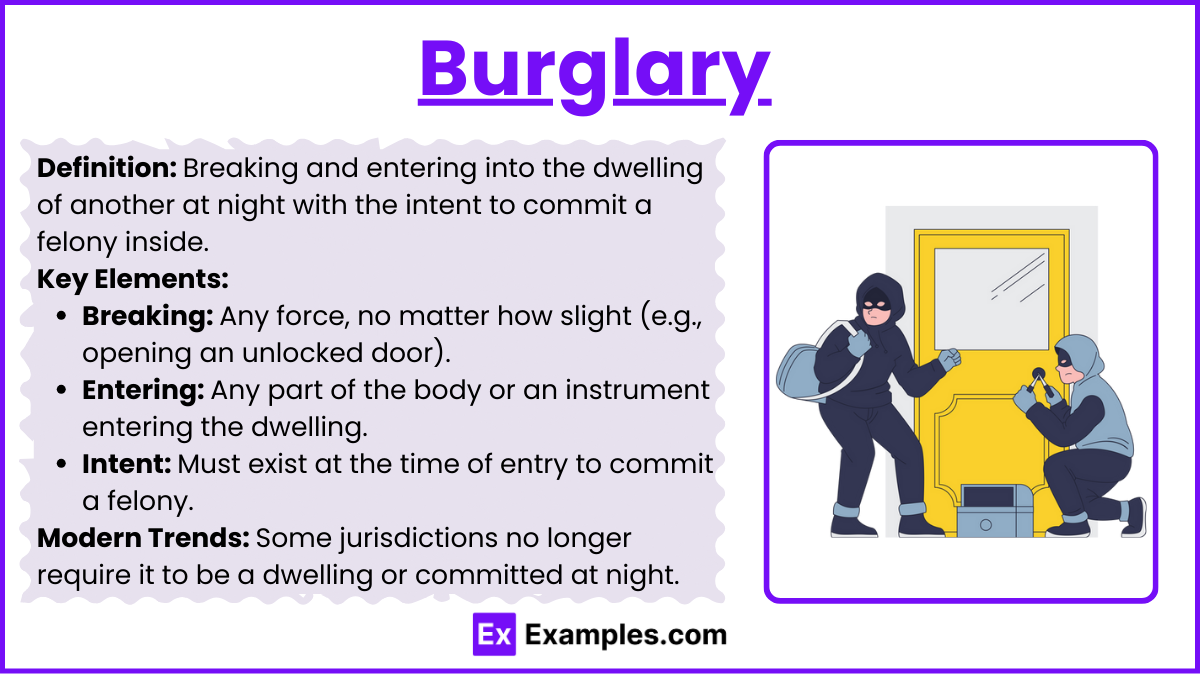
Definition: Breaking and entering into the dwelling of another at night with the intent to commit a felony inside.
Key Elements:
Breaking: Any force, no matter how slight (e.g., opening an unlocked door).
Entering: Any part of the body or an instrument entering the dwelling.
Intent: Must exist at the time of entry to commit a felony.
Modern Trends: Some jurisdictions no longer require it to be a dwelling or committed at night.
3. Robbery
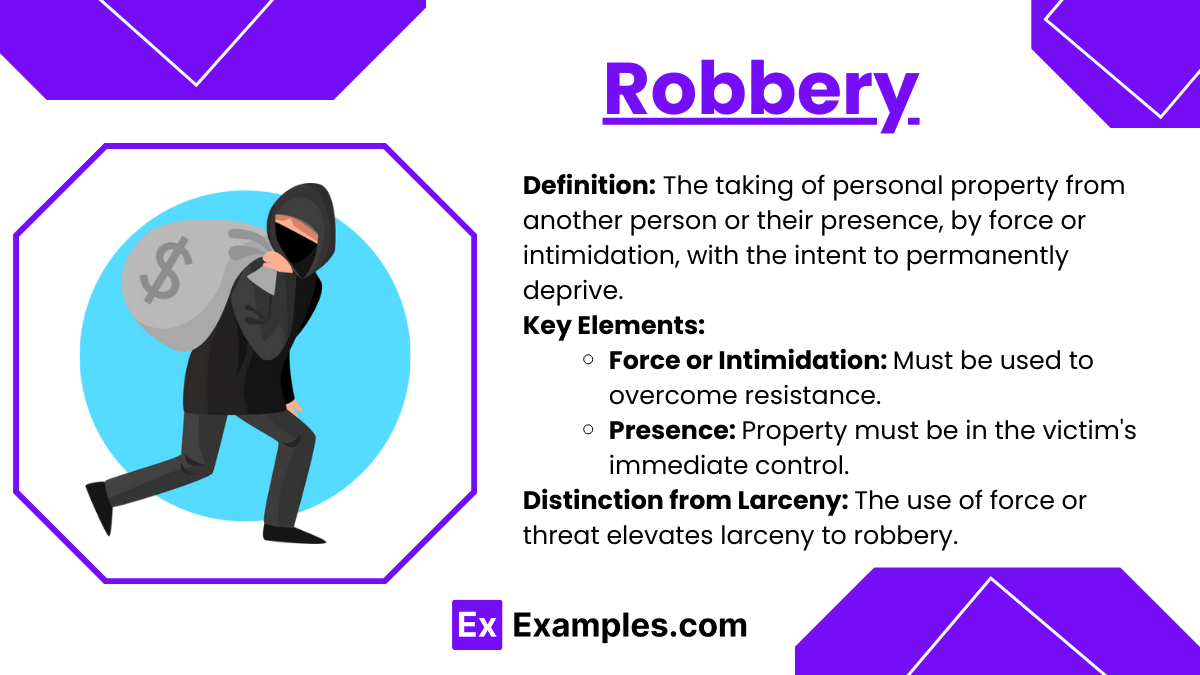
Definition: The taking of personal property from another person or their presence, by force or intimidation, with the intent to permanently deprive.
Key Elements:
Force or Intimidation: Must be used to overcome resistance.
Presence: Property must be in the victim's immediate control.
Distinction from Larceny: The use of force or threat elevates larceny to robbery.
4. Arson
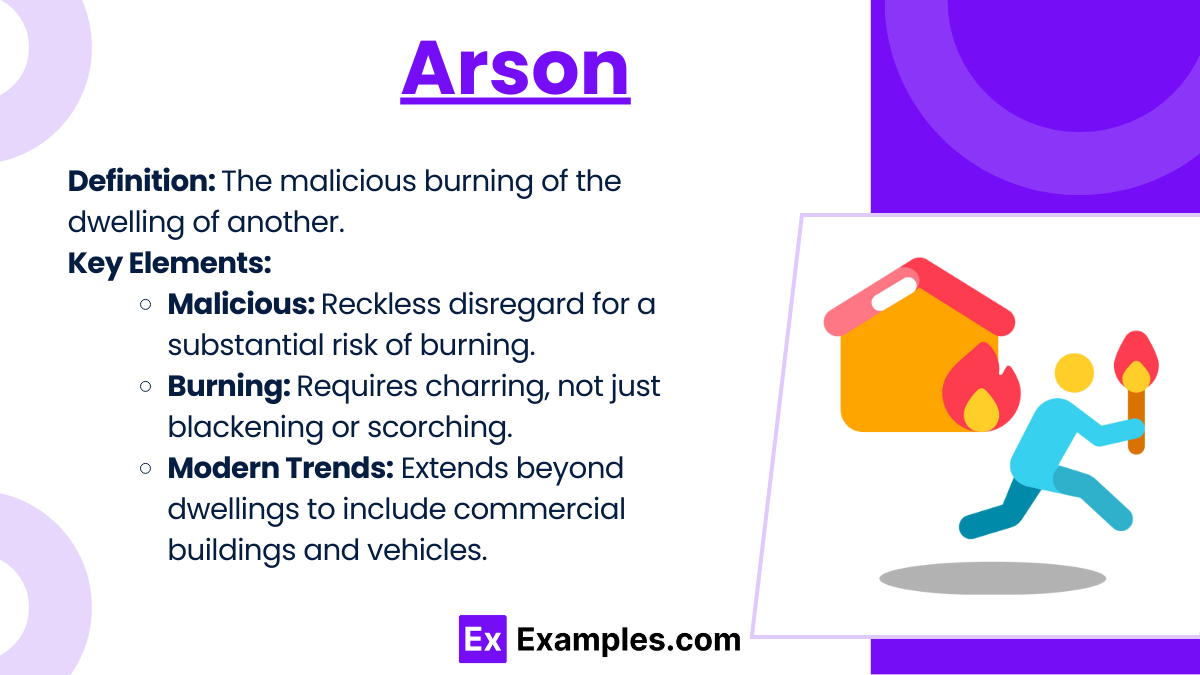
Definition: The malicious burning of the dwelling of another.
Key Elements:
Malicious: Reckless disregard for a substantial risk of burning.
Burning: Requires charring, not just blackening or scorching.
Modern Trends: Extends beyond dwellings to include commercial buildings and vehicles.
5. Embezzlement
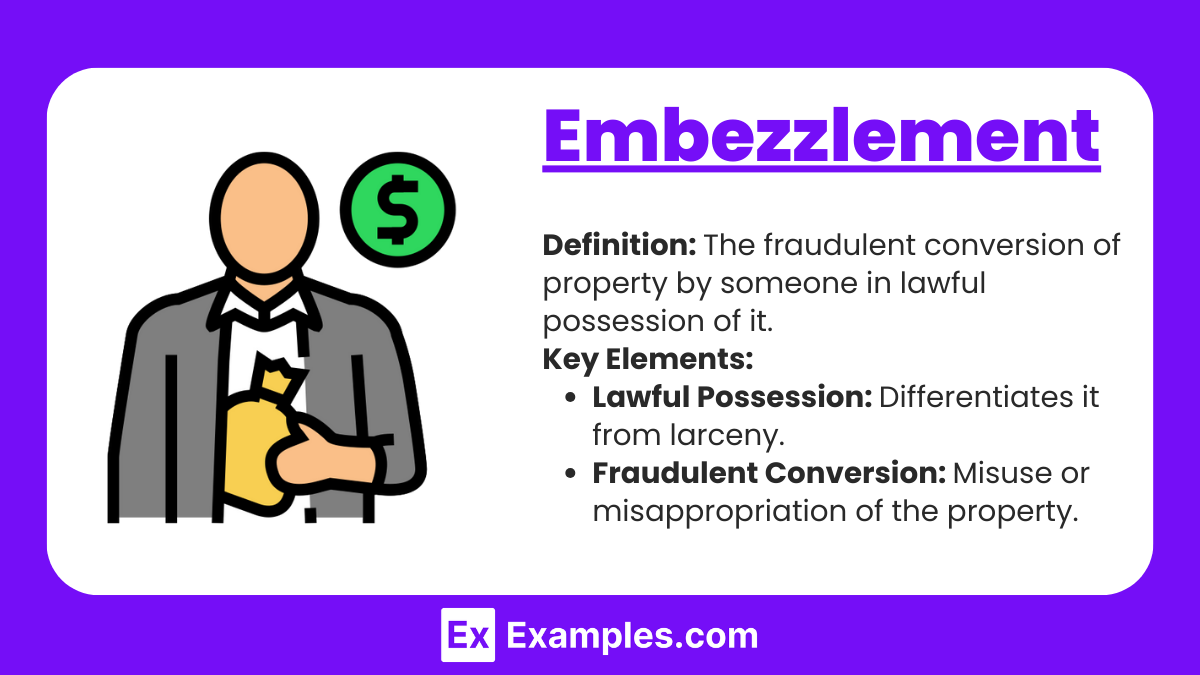
Definition: The fraudulent conversion of property by someone in lawful possession of it.
Key Elements:
Lawful Possession: Differentiates it from larceny.
Fraudulent Conversion: Misuse or misappropriation of the property.
Applications of Other Crimes
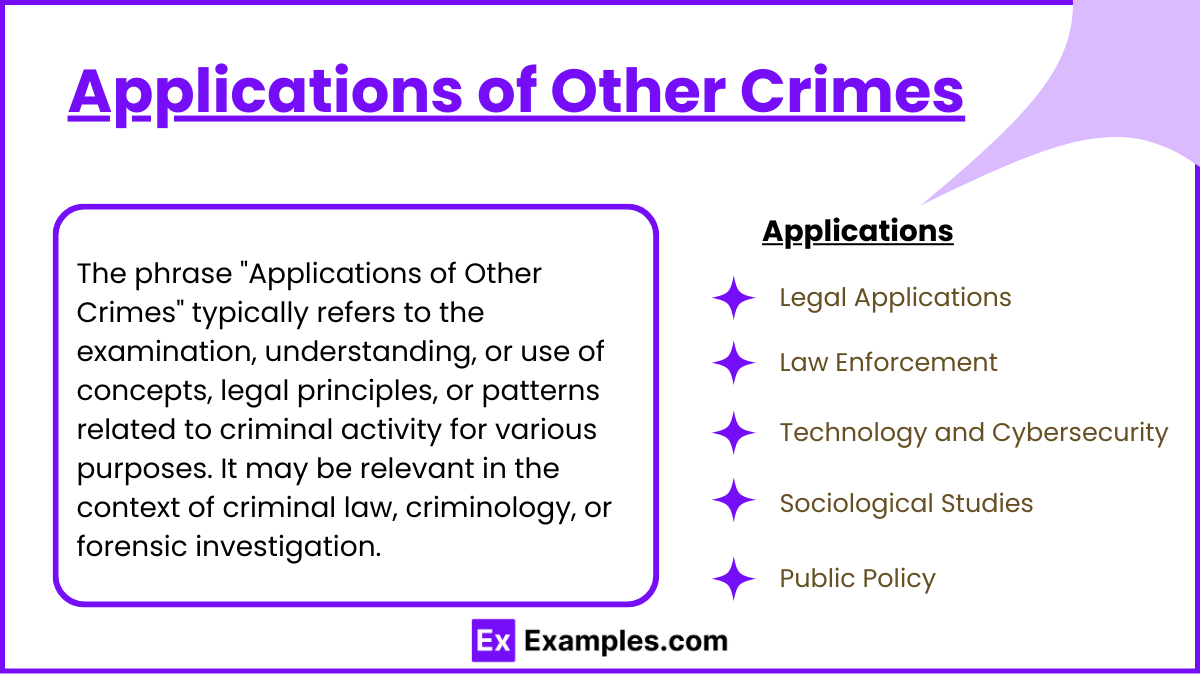
"Other crimes" encompass a wide range of criminal activities beyond common categories like theft, fraud, or violent crimes. Their applications in legal, law enforcement, and sociological contexts include:
1. Legal Applications
Sentencing Guidelines: Classifying crimes to establish appropriate penalties.
Defense Strategies: Understanding nuances in lesser-known crimes to build defense cases.
Legislative Reforms: Highlighting gaps in laws for improved legislation.
2. Law Enforcement
Investigation Techniques: Specialized methods for unique crimes like cyberstalking or wildlife trafficking.
Resource Allocation: Focusing manpower on emerging or localized criminal activities.
Data Analysis: Tracking trends in unconventional crimes to predict and prevent them.
3. Technology and Cybersecurity
Digital Forensics: Tools to combat cybercrimes like hacking or online impersonation.
AI Implementation: Identifying patterns in white-collar crimes or human trafficking.
Blockchain Monitoring: Detecting crimes in cryptocurrency transactions.
4. Sociological Studies
Understanding Motivations: Analyzing why certain crimes occur, such as hate crimes or environmental offenses.
Crime Prevention Programs: Developing education or awareness campaigns tailored to specific crimes.
Impact Studies: Evaluating societal impacts of crimes like insider trading or healthcare fraud.
5. Public Policy
Policy Making: Creating regulations to address emerging threats like e-waste trafficking.
Community Engagement: Empowering citizens to report and prevent crimes.
Collaboration: Working with international bodies on cross-border crimes.
Examples
Example 1. Comparison of Offenses
Other crimes, such as vandalism or trespassing, often have distinct legal consequences compared to more severe offenses like armed robbery. While the latter may carry prison sentences, the former could result in fines or community service, highlighting the varying severity within criminal law.
Example 2. Criminal Profiling
When analyzing a suspect’s behavior, investigators often examine their involvement in other crimes, such as fraud or minor theft, to establish patterns or motives that could link them to a larger, ongoing criminal operation.
Example 3. Juvenile Delinquency Cases
Young offenders charged with other crimes, like shoplifting or underage drinking, are often given alternative sentencing options, such as counseling or probation, to focus on rehabilitation rather than punishment.
Example 4. Media Reporting
News outlets frequently bundle discussions of violent crimes with other crimes, such as drug trafficking or illegal gambling, to provide a comprehensive overview of the challenges law enforcement faces in maintaining public safety.
Example 5. Policy Analysis
In policy debates, addressing other crimes like white-collar fraud or cyber offenses is critical to ensuring that resources are allocated not just to combat violent crime but also to tackle less visible, yet equally harmful, criminal activities.
Practice Questions
Question 1
Which of the following is an example of a "white-collar crime"?
a) Robbery
b) Embezzlement
c) Assault
d) Burglary
Correct Answer: b) Embezzlement
Explanation:
White-collar crimes are non-violent offenses typically committed by individuals in professional settings, involving deception for financial gain. Embezzlement fits this definition as it involves the illegal taking of money or property entrusted to someone's care, usually in a business or professional environment. In contrast, robbery, assault, and burglary are violent or property-related crimes.
Question 2
Which of the following is considered a crime against property?
a) Larceny
b) Homicide
c) Kidnapping
d) Extortion
Correct Answer: a) Larceny
Explanation:
Crimes against property involve unlawfully taking or damaging someone's property. Larceny, defined as the theft of personal property without violence, is a clear example. Homicide and kidnapping are crimes against individuals, while extortion involves coercion or threats, making it more complex than simple property theft.
Question 3
Which of these is a characteristic of a hate crime?
a) Motivated by greed
b) Targeting specific groups based on identity
c) Committed during armed conflict
d) Resulting from negligence
Correct Answer: b) Targeting specific groups based on identity
Explanation:
A hate crime involves criminal acts motivated by bias or prejudice against a person or group based on race, religion, sexual orientation, or other identity factors. This distinguishing feature separates hate crimes from other offenses driven by greed, conflict, or negligence. These crimes aim to intimidate not just the victim but the community the victim represents.

